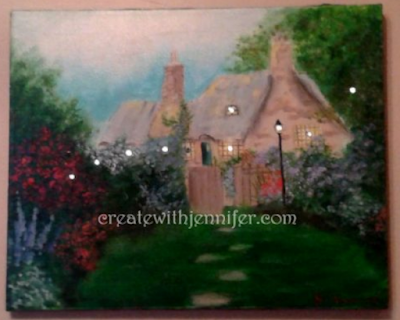Watch How I DIY a Valance From a Long Curtain Drape!
(Originally published on 6/5/18)
OK, long story short....I'm not an experienced seamstress. Just someone with a goal. This goal? To repurpose a shorter valance style curtain from a long flowy drape.
Sounds doable for an ingenue right? After all it's not something that will require a pattern and extensive labor-unfortunately it didn't go that smoothly.
I have always preferred shorter curtains...Long, flowy drapes are nice but they always seem to be too susceptible to curious kitty claws, plus gathering more dust, mites and generally, cat hair gets on them and when you're talking about white drapes with a black cat around, boy, it shows. Last week I laundered my long white drapes which kept falling down due partly to our cats' shenanigans and partly the rod at the top being persnickety.
Then I went on to replace them with a short white topper. But then...there's that little bugaboo of all that space below them. I think that is why curtain valances were invented....that midrange point on a window and below it...just makes me feel much, uh, like I have less privacy. Short curtains with valances give the win-win of a nice view at the top without having to close and tie-back long drapes, plus the privacy right where it is needed.
OK...I don't actually own any valances, just a surplus of panels. I got this idea just today. Since my panels are the same colors basically as the "shorties", I just took them and folded them in half and then after holding them up to the window to check for adjustment...folded a little bit of the top . I have those little hook thingys that I use for curtain tiebacks. I used sewing clips to secure the folded-over panel to the hooks and ta da...It's a little primitive, but it works. For now. We live in a neighborhood where you can easily get flagged for having unsightly stuff that faces the front of the house so I try to make sure I don't raise eyebrows too much:)
It's relatively mild...I live in Georgia and everyone is usually cranking out their ACs by May, but we've been having a lot of pop-up showers lately so it's stayed in the low 80s which is nice and allows for a good bit of window cracking. It makes the humidity bad but when the air is coming in it's a lot better. My cats love sitting on the windowsill to peer out at the outside world so I made sure my makeshift valance was positioned enough so they could sit there (and not easily yank it) and the air would get in freely.
My DIY Curtain Valance...A Partial Epic Fail??
So I was wanting to hem up I did here last week...this was only a makeshift "valance" Now comes the real thing. Gotta hem those babies up so they will be actual curtains, not a stopgap solution :)
Here are my long curtains that I wanted to make into short valances. I was in a quandary; because as you can see the pom-poms are lining the outer edges and bottom. I at first was okay with just one panel but realized that one side in that case, would be absent of the cute pom poms.
Which meant that I had to measure and cut in a different place...I had already measured the window from the point that the rod should go in to the windowsill.
So I cut the drapes at that point into equal lengths. That part was easy but now...
Ever heard the term "Murphy's Law" (if a thing can go wrong it will) Well what I want to know is, who is Murphy and why does he have it out for some of us? Is this Murphy some kind of gleeful sadist? Well, what went wrong over the course of this evening? Well, what didn't go wrong is more like it.
First off my cat got a hold of my bag of straight pins. Picking them up off of a rug...ugh.
I almost made some real headway, but then I got short of thread on one side and didn't know why until I discovered that the bobbin had run out of thread. I didn't know how to reload that thing until I pulled up a Youtube video. Thank goodness for that repository of how-to's for all of us when we are clueless and stumbling.
Fortunately I did manage to hem up the first panel. I wanted it to have a flanged edged too so it wouldn't look so amateurish, so I did manage to get that stitch under way. But trouble came when I started on the second panel and everything went wrong. And if all that wasn't bad enough....
My needle broke!!!
(Insert string of curse words right about now.....this would have been a good time to get out that sweary word coloring book)
This was just not. my. day. Well, not for sewing anyway....
So that's why you're only seeing this one panel as you do in this picture at the top.
Maybe I just lack the coordination for this, or maybe it is because I detest needles. Who knows? The one thing I really took to was needlepoint as a kid because I had a plastic needle that wouldn't stick me and I got to work with yarn and not skinny scrawny thread.
If you're an experienced seamstress and you're reading this right now, please get in touch :) It could be that I just don't have any guidance in this department. That may be what I need. Anything that would help me get back to finishing that other panel is about all I'd be happy with right now!












